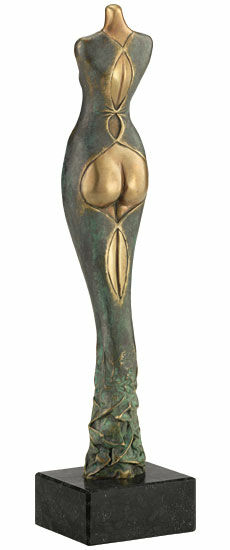Sculpture "The Model", bronze
Sculpture "The Model", bronze
Quick info
limited, 199 copies | numbered | signed | bronze + stone | patinated | polished | size total 29 x 7 x 6 cm (h/w/d) | weight 1.1 kg
Detailed description
Sculpture "The Model", bronze
Becker's sculpture adds a third dimension to his two-dimensionally formulated picture "Dazzling Appearance". The effect here is also well-calculated: it appears both graceful and voluptuous in its forms and is at the same time of great elegance, which is further emphasised by the contrast of the highly polished body and the dark patinated robe.
Edition in fine bronze. Cast using the Lost-Wax-Process, partly patinated and polished. Limited edition 199 copies, signed and numbered. Size diabase pedestal 3 x 7 x 6 cm (h/w/d). Total size 29 x 7 x 6 cm (h/w/d). Weight 1.1 kg.

About Michael Becker
Michael Becker's symbioses of nature and femininity.
"Art with pleasure" – this is the motto that Bremen artist Michael Becker has chosen for his work. The graphic artist, illustrator, painter and sculptor creates fantastically surrealistic and figurative symbioses of humans and nature - combined with erotic allusions, irony and humour. "My art should be fun and aesthetic," he says.
Born in 1951, Becker initially worked for many years as a graphic designer and began his exhibition activities as an artist in 1994. Becker's imagery is fantastic in the third dimension while striving for perfect aesthetics. It aims to express beauty in the classical sense. In doing so, his motifs repeatedly bring together the themes of humans and nature, mostly in the depiction of erotic female figures that do not compete with the beauty of nature but are deeply symbiotic with it.
"For me, nature has the essence of a woman, inspiring, fascinating, impressive and full of transformations."
An alloy of copper with other metals (especially with tin) used since ancient times.
When casting bronze, the artist usually applies the lost-wax technique which is dating back more than 5000 years. It's the best, but also the most complex method of producing sculptures.
First, the artist forms a model of his sculpture. It is embedded in a liquid silicone rubber mass. Once the material has solidified, the model is cut out. The liquid wax is poured into the negative mould. After cooling down, the wax cast is removed from the mould, provided with sprues and dipped into ceramic mass. The ceramic mass is hardened in a kiln, whereby the wax flows out (lost mould).
Now we finally have the negative form, into which the 1400° C hot molten bronze is poured. After the bronze had cooled down, the ceramic shell is broken off and the sculpture is revealed.
Now the sprues are removed, the surfaces are polished, patinated and numbered by the artist himself or, to his specifications, by a specialist. Thus, each casting becomes an original work.
For lower-quality bronze castings, the sand casting method is often used which, however, does not achieve the results of a more complex lost-wax technique in terms of surface characteristics and quality.
Term for an art object (sculpture, installation), which is produced in multiple copies in a limited and numbered edition according to the artist‘s will.
Artist's multiples have been called the most accessible and affordable art on the market.
A plastic work of sculptural art made of wood, stone, ivory, bronze or other metals.
While sculptures from wood, ivory or stone are made directly from the block of material, in bronze casting a working model is prepared at first. Usually, it is made of clay or other easily mouldable materials.
The prime time of sculpture after the Greek and Roman antiquity was the Renaissance. Impressionism gave a new impulse to the sculptural arts. Contemporary artists such as Jorg Immendorf, Andora, and Markus Lupertz also enriched sculptures with outstanding works.






